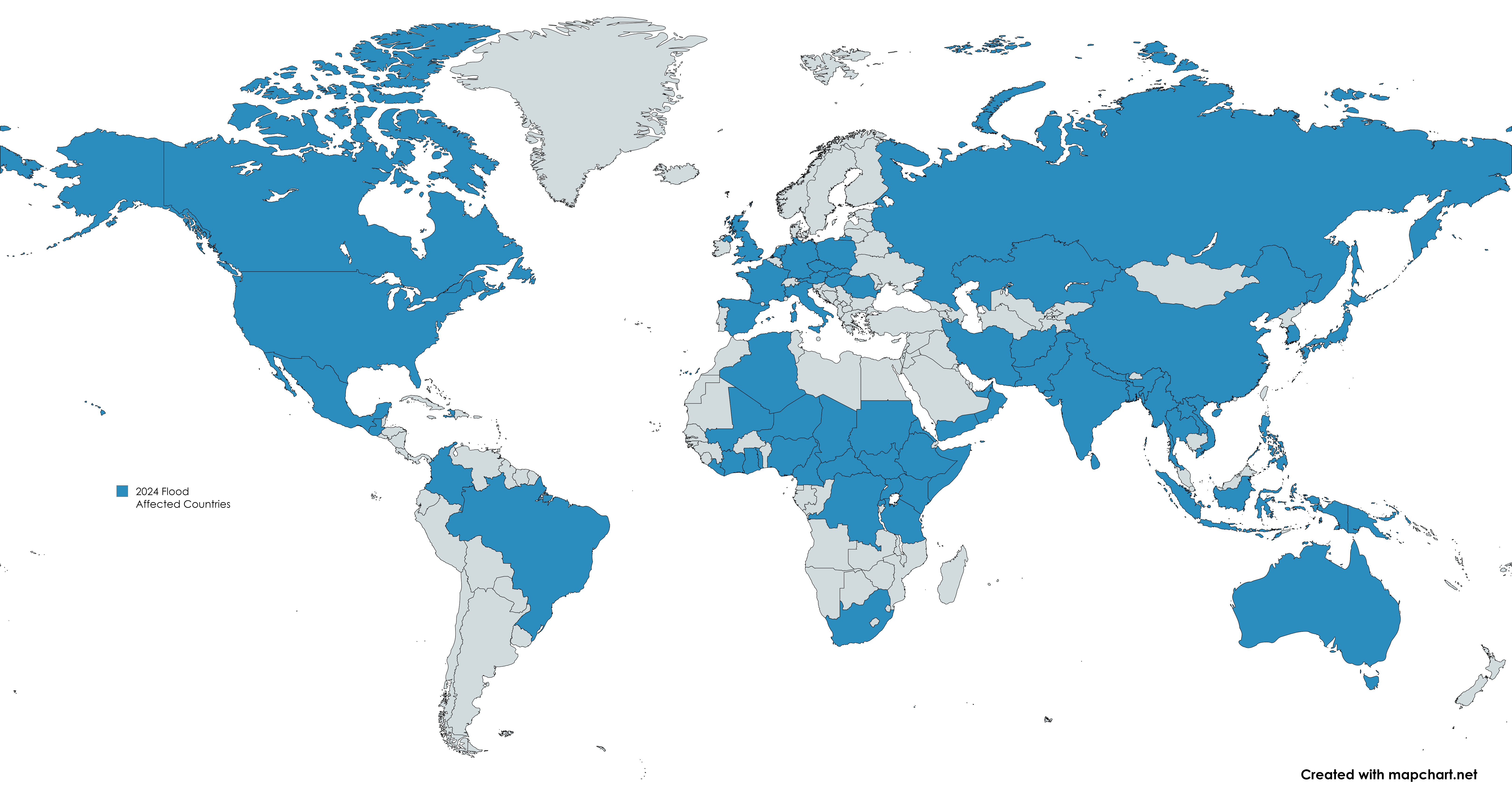No community is immune to flooding: Compounding disaster risks and the path forward

A few weeks ago, in our weekly disaster meeting, it seemed like we were discussing flooding in every corner of the globe—devastating floods from Hurricane Helene in the southeast United States, floods in central and eastern Europe, floods in west and central Africa, floods in Nepal – water everywhere!

On the map above, we’ve marked in blue every flood-affected country featured in our weekly What We’re Watching blog post in 2024—it’s a lot of blue! We know that flooding is the most common and most costly disaster, yet it often receives the least amount of attention or resources. In the U.S., flood plain maps are mostly outdated and don’t tell the whole story when planning for potential impact.
It may be easy to think that some regions are immune—arid deserts, elevated areas, or places with advanced drainage systems—but the truth is that no community is entirely safe from the risks of floods. Flooding is often a subsequent impact of other disasters such as hurricanes, wildfires and droughts, and its compounding effects on already vulnerable communities can be devastating.
Flooding as a consequence of other disasters
While flooding can cause a disaster, it can also be the aftermath of other catastrophes. Wildfires, for example, can burn away vegetation that typically holds soil in place, resulting in flooding when the same area is hit with rainfall. We saw this happen earlier this year when the scenic town of Ruidoso, New Mexico, experienced a “double-barreled” disaster after two massive fires broke out. Then, multiple flooding events followed, with waters cascading down the torched mountains, creating even more damage to an already devastated area. Without a natural barrier, even moderate rainfall can cause flash floods or landslides that exacerbate the already devastating effects of the previous disaster.
Hurricane-driven storm surges bring mass amounts of water inland, often overwhelming existing drainage systems and leading to widespread flooding. For example, Hurricane Helene caused devastating flooding, impacting communities hundreds of miles from the coast. Communities that never expected to be affected by a hurricane are now recovering from water levels not seen before.
Drought-stricken regions, counterintuitively, are also susceptible, as we saw with the floods in East Africa after a long period of drought. When the ground is too dry, it can harden, making it less absorbent when rains eventually come, thus leading to flooding.
The intersections of these events make it clear that flooding doesn’t just happen in isolation—it compounds existing vulnerabilities and puts even more pressure on communities already dealing with crises. In places where people are already displaced, like the recent flooding in Bangladesh, or in areas with aging or inadequate infrastructure, flooding can be catastrophic.
Vulnerabilities exacerbated by flooding
The compounding effects of flooding on communities already struggling with other vulnerabilities can’t be overstated. People living in poverty, displaced populations, and regions with limited access to resources are often hit the hardest. When flooding strikes these areas, it devastates homes, infrastructure and livelihoods, and the road to recovery becomes exponentially more difficult.
For example, communities already coping with poor infrastructure are less likely to have effective flood adaptation and management systems. Displaced populations—from conflict, climate change or economic pressures—are often housed in more flood-prone areas, with limited resources to protect themselves. Additionally, economic inequality can make it difficult for certain communities to recover and rebuild after a flood, leaving them in a cycle of vulnerability.
Unfortunately, too often, communities affected by flooding that isn’t associated with a larger scale, high-attention disaster do not receive the attention and the resources they need to adequately and equitably recover. As we see more and more climate-related disasters occurring globally, it’s harder to draw attention to the needs of more isolated or rural communities with significant recovery needs.
Solutions for supporting flood-prone communities
While no community is entirely immune to flooding, there are steps we can take to mitigate its impact and support those most vulnerable. Here are some key solutions:
- Advocate for updated mapping and flood data
Flood maps are essential for understanding the risks communities face, but many of the maps used today are outdated. Communities need accurate, up-to-date flood risk assessments that account for the evolving impacts of climate change and shifting weather patterns. Advocating for updated flood data and mapping is crucial to ensure everyone—from government officials to individual homeowners—can make informed decisions about protecting themselves from floods. - Invest in preparedness and infrastructure
Infrastructure plays a critical role in flood management. Investments in resilient infrastructure—such as improved drainage systems, levees, flood barriers or other innovative ideas like Bangkok’s city forests—can help minimize the impact of flooding when it does occur. Beyond infrastructure, there’s also a need to invest in community preparedness, ensuring local governments and residents have the resources and knowledge to respond effectively when floods happen. This could include emergency response plans, flood warning systems and community education programs. - Invest in resilient rebuilding
After a flood, rebuilding shouldn’t just mean returning to the status quo. We need to ensure that communities are rebuilt in a way that prepares them for future risks. This means constructing homes and infrastructure that can withstand floods, developing community-based resilience programs, and ensuring recovery funds are used to rebuild and build back better. - Pay attention to affected communities
One of the most important things we can do is pay attention when floods hit communities, especially those that are marginalized or underserved. Disasters tend to draw fleeting attention, but the impact can be long-lasting for those affected. After the floodwaters recede, the recovery process continues for months or even years. Communities need sustained support to rebuild in a resilient way—support that includes financial aid, access to resources and infrastructure that will protect them from future flooding events. Support local organizations in communities with flexible, long-term funding, or CDP can help you move money and resources to local organizations and systems. We currently have funds that will continue to address flood-related needs in the US and internationally:
Our colleague, Cari Cullen, who directs the CDP Midwest Early Recovery Fund, shared some insights about flooding in the U.S. and how philanthropy can be supportive, especially in rural communities, here.
Flooding may be inevitable, but the degree of its impact is not. As the frequency and intensity of floods continue to increase in the face of climate change, taking proactive steps now is more important than ever.
No community is immune to flooding, but by working together, we can ensure that every community is better prepared for it.

